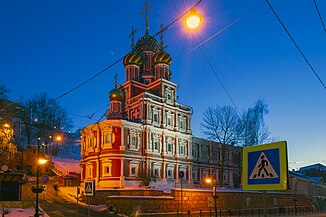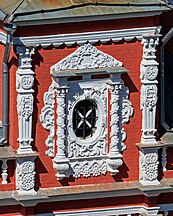Stroganov Church
- Machine translation, like DeepL or Google Translate, is a useful starting point for translations, but translators must revise errors as necessary and confirm that the translation is accurate, rather than simply copy-pasting machine-translated text into the English Wikipedia.
- Do not translate text that appears unreliable or low-quality. If possible, verify the text with references provided in the foreign-language article.
- You must provide copyright attribution in the edit summary accompanying your translation by providing an interlanguage link to the source of your translation. A model attribution edit summary is
Content in this edit is translated from the existing Russian Wikipedia article at [[:ru:Рождественская церковь (Нижний Новгород)]]; see its history for attribution. - You may also add the template
{{Translated|ru|Рождественская церковь (Нижний Новгород)}}to the talk page. - For more guidance, see Wikipedia:Translation.
Church of the Nativity of the Blessed Virgin Mary (Russian: Церковь Собора Пресвятой Богородицы), better known as Nativity or Stroganov is a Russian Orthodox church, located at the Rozhdestvenskaya Street in Nizhny Novgorod. It was built in 1696–1719 on the means of the merchant Grigory Stroganov.
History

The construction of the church began in 1696. The construction was almost completed by 1701, but a fire broke out in the temple. The burnt down church was restored by the wife of merchant Grigory Dmitrievich Stroganov - Maria Yakovlevna. It was consecrated in 1719 by Archbishop Pitirim of Nizhny Novgorod and Alatyr (1719-1738).[1]
In 1722, the church was closed by Peter the Great until his death (1725). The temple was often burning (in 1768, 1782, 1788). In 1807-1812 Alexander Stroganov carried out major repairs. In the 1870s and 1880s, the church was thoroughly restored by the projects of Lev Dahl and Robert Kilevain.
In the 1860s the belltower start to lean, and in 20 years has deviated by 1.2 meters. In 1887, its upper tiers were dismantled and collected again.
In the Soviet era, a decision was made to destroy the church, but the rector of the church Sergius Veisov (1915-1934) collected historical documents and photographs, read several lectures on the cultural significance of the Stroganov Baroque, and preserved this temple.[2]
The church was again consecrated July 3, 1993.
Architecture

The church is two-level: at the top there is a three-apsidal altar, a prayer hall, a refectory and a porch. Outside and inside the church is decorated with white stone carvings.
The belltower is an octagon on cube. The dome is crowned with a cross with a weather vane. On the stone slabs there are Slavic letters that divide the circle into 17 parts, according to the Old Russian calculation of time. The fate of the previous mechanism is unknown. A new mechanism has now been installed.
Gallery
-
 Night view from Rozhdestvenskaya Street
Night view from Rozhdestvenskaya Street -
 View from the side of the slope
View from the side of the slope - Interior of the church
-
 Window
Window -
 The dome of the belltower
The dome of the belltower















